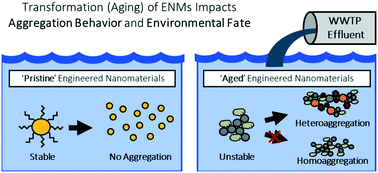Comparing the fate of pristine and wastewater-aged gold nanoparticles in freshwater†
Abstract
The surface coatings applied to engineered nanomaterials (ENMs) during their manufacture have been shown to affect their aggregation behavior in aquatic media. This phenomenon has important implications on the environmental fate of ENMs and is often examined using ENMs in their ‘pristine’ form. However, the physiochemical properties of ENMs will be altered during their life cycle. Engineered systems, such as sewers and wastewater treatment plants, represent one pathway wherein ENMs can be transformed prior to their release. The focus of the current study was to compare the aggregation behavior of ‘pristine’ and ‘wastewater-aged’ ENMs in freshwater to provide insights into the impact of wastewater aging on ENM environmental fate. Gold nanoparticles (AuNPs) coated with polyethylene glycol (PEG), lipoic acid (COOH) and branched polyethylenimine (bPEI) were selected as model ENMs. The AuNPs were aged in filtered primary wastewater using a previously reported technique. The aged and pristine AuNPs were dosed into separate samples of raw and filtered freshwater and the loss of AuNPs from suspension by aggregation and sedimentation quantified using inductively coupled plasma mass spectrometry. Regardless of the initial surface coating, the AuNPs homoaggregated and acquired an organic matter corona while aging in the wastewater media. Following dispersion in the raw and filtered river water, the aged AuNPs were consistently lost from suspension. Greater loss was observed in the raw river water compared to the filtered river water, demonstrating that the aged AuNPs undergo heteroaggregation in addition to the homoaggregation that occurred during the aging process. This contrasts with the behavior of the pristine AuNPs, which were generally resistant to aggregation. These results indicate that while the physiochemical properties of the pristine AuNPs largely prevent their aggregation and subsequent sedimentation in the river water, the stabilizing effects of the engineered surface coatings examined in this study are lost after aging in wastewater. This demonstrates the importance of explicitly accounting for ENM transformations when designing experiments and selecting materials intended to elucidate the factors impacting ENM environmental fate.



 Please wait while we load your content...
Please wait while we load your content...